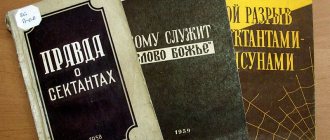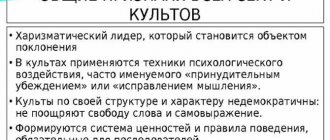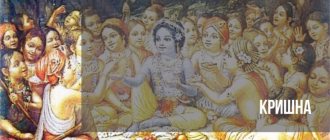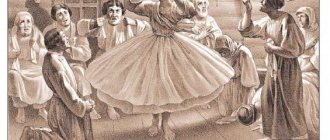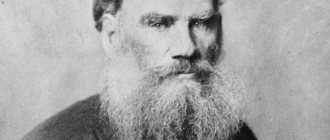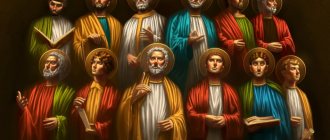The Essenes were a Jewish sect, the Pharisees and Sadducees were its opponents
The Essenes, a sect that existed during the Second Temple, originated from Judaism. This is also the period of the earthly ministry of Jesus Christ. Historians claim that they carried out their activities approximately from the 2nd century BC to the third quarter of the 1st century. from R.H. The name of the sect means, translated from Aramaic, “pious” or “healers.”
An image found on the wall of one of the caves where the Essenes lived.
The Essenes sect is not mentioned in the Holy Scriptures; all information about them is taken from archaeological finds, reports of ancient authors and manuscripts found in the Qumran caves. Photo: acathist.ru
The Essenes are not mentioned anywhere in the Holy Scriptures. Basic information about them was obtained from the writings of ancient historians Philo of Alexandria, Pliny the Elder, Josephus and others.
The Essenes were opposed to the Sadducees and Pharisees, the other two sects of Roman-era Judaism. At one time, Josephus Flavius and Philo of Alexandria numbered 4,000 contemporary Essenes.
4000 Essenes
lived in the country during the Roman Empire
The Essenes were scattered in Palestine and at first lived in cities and villages under the name of Assideans. They fought against the supporters of Hellenistic customs, the Saduccees and the Pharisees. The Saducees are an ancient Jewish philosophical and religious school that recognizes only the law of Moses.
The Pharisees, a group of Jews with a strict attitude to piety, demanded the most careful observance of Jewish law and tradition. Often the word “Pharisee” is used as a synonym for the word “hypocrite.”
Josephus Flavius.
Josephus - Jewish historian and military leader. Josephus is known for his works that have come down to us in Greek - “The Jewish War” and “Jewish Antiquities”. From these writings we can in our time obtain information about the sect of the Eeseites. Photo: gracetime.ru
Deciding that city life was spoiled and degenerate, and also realizing that they could not play a serious role in the life of Jewish society, the Essenes withdrew from public life. They stopped visiting the Old Testament Temple and moved to the northwest of the Dead Sea, establishing separate colonies there.
It is likely that the Essenes were among the followers of Christ, but many also did not accept Him. As a result, the followers of this teaching turned into Judaizing Gnostic sects and soon disappeared.
Basic information
Scholars differ regarding the Greek name "Esseni" (esseni); most common theories: from Hebrew חֲשָׁאִים, `silent' or חֲסִידִים, `pious'; from Syriac חסין, `pious`; from Aramaic אסא, `to heal`.
The Essenes had much in common with the Pharisees: both believed in the need for personal piety and removal from the filth of everyday life, as well as in posthumous reward (unlike the Pharisees, the Essenes believed in the physical resurrection of the dead). But while the Pharisees took an active part in the life of contemporary society even when the temple service was controlled by the Sadducees, the Essenes formed a separate and closed brotherhood. They considered themselves the only true Israel, since, in their opinion, religious life in the cities and the Temple were hopelessly corrupted.
Some scholars view the Essenes as a branch of the Pharisees who strove to achieve the highest degree of piety and followed the strictest rules of holiness and ritual purity, and consider the religious instructions in the so-called Temple Scroll to be the laws of the Essene community. Many of these injunctions diverge from the Halachah, which was developed much later by the Pharisees, and are marked by a tendency to over-interpret the laws of the Bible.
The Essenes lived in the Qumran area, the Gospel of the Essenes was found here
During the time of the Old Testament, the state of Jewish society did not meet its requirements. Moreover, among the Jews there were believers who actually sought to lead a moral life in accordance with the Law of Moses.
In some cases, they fenced themselves off from society and joined various kinds of ascetic communities. They believed that life here meets the norms of God's Law. This is how sects were created in Judea.
Wadi Qumran and panorama of Qumran National Park from the south.
The Wadi Qumran area is located next to the Dead Sea. It is rich in caves of natural and artificial origin. Members of the Essene community lived in them. Photo: i0.wp.com
One of these sects was the Essenes sect. Pliny the Elder reports that its members lived in the Wadi Qumran area. Qumran is located near the Dead Sea, it is a sparse area rich in rocks with caves in them.
In these caves, manuscripts of the community of ascetics who lived here at the time of Christ were discovered. The Qumran community kept ancient manuscripts here, which were called the Dead Sea Scrolls.
Members of the Essenes sect lived near the Dead Sea in the Wadi Quman area.
Most researchers identify this community with the Essenes. As for the scrolls themselves, they contained and still contain fragments from the Pentateuch.
In addition, the researchers also discovered in them a passage from the Gospel of Mark, recognized as the oldest known to date. These documents also describe the lifestyle of the Essenes.
Qumran.
Dead Sea Scrolls. Scrolls discovered in the caves of Qumran, which were hidden there by members of the community during an attack by Roman soldiers, made it possible to learn a lot about the faith and way of life of the Essenes. Photo: prichal.com
Historians, having studied the found scrolls, found that they were hidden in caves by members of the community around 66 AD. during one of the Jewish uprisings. In addition, they argue that the Essenes adhered to a hermitic lifestyle, like the Therapeutians and Hemero-Baptists, while the early Essenes are compared to the Pharisees.
At the same time, a connection between the Essenes and the followers of later Hasidism, Kabbalism and various secret societies can be traced.
Literature
- Vladimirov A.
Qumran and Christ. - M.: Belovodye, M., 2002. - Amusin I. D.
Finds at the Dead Sea / Executive editor V. V. Struve. - M.: “Science”, 1964. - Amusin I. D.
Dead Sea Manuscripts / Executive editor S. I. Kovalev. - M.: Publishing House of the USSR Academy of Sciences, 1960. - Elizarova M. M. Community of therapists (from the history of the Essene socio-religious movement of the 1st century AD) Executive editor I. D. Amusin M, “Science”, Main Editorial Board of Oriental Literature, 1972
- Zusman A. Essei: Religious movement in Palestine during the time of Jesus Christ M, 1913
- Lebedev P. A., prot. Essenes and Pherapevts Spirit of Christian 1862
- Lucius. Der Essenisinus und das Judenthum 1889
- Lurie S. Ya. Essenes Historical Review 1892 vol. IV
Essev School according to Josephus
According to the testimony of the famous Roman historian Josephus, the Essenes believed in One God and recognized the immortality of the soul. In addition, after God they revered the lawgiver Moses. One of the Essenes who blasphemed Moses was punished by death.
The community members also observed the Sabbath, did not take oaths, and prayed at sunrise and sunset. They did not make bloody sacrifices, they taught that they were brothers with each other and therefore tried to help each other in every possible way.
Prophet Moses.
Monastery of St. Catherine, Sinai, Egypt. The Essenes revered the law of Moses and, for blasphemy against it, executed the blasphemer by death. Photo: www.pravoslavie.ru
The center of life of the Essene community was considered the house where they ate a common meal. She accepted the rite of worship. If the Essenes are in complete silence. Usually they both consisted of one dish and bread.
The Essenes' meal consisted of one dish.
In ordinary life, they were engaged in agriculture, beekeeping, and cattle breeding. Some of them studied a trade. In addition, among the Essenes there were many healers who treated the sick with the help of medicinal plants and breathing exercises.
Brotherhood of the Essenes, drawing, reconstruction.
The Essenes could eat food only by accepting it from the hands of other members of the community. If an Essene was expelled from it, he could die of hunger because of the vow he had taken. Photo: ru.santosepulcro.co.il
During the existence of the Essenes sect, the Jewish War was going on, and some of its representatives participated in it, despite the fact that their teaching forbade making weapons. The community members also rejected wars before the coming of the Messiah. At the same time, they were preparing for a war against the forces of Evil on the side of the Messiah.
August Neander claims that the Essenes borrowed their teaching from the Chaldeans
There is still serious debate about the origin of the Essenes' teachings. Thus, the German Church historian August Neander believes that the Essenes school borrowed its teachings from the Chaldeans, that is, Semitic tribes, during the Babylonian captivity. Other scientists claim that the basis of their teaching is Greek and Pythagorean ideas, and not Jewish ones.
August Neander.
German Protestant theologian and church historian. Neander believed that the Essenes borrowed their teachings from the Chaldeans during the Babylonian captivity. Photo: upload.wikimedia.org
Researchers such as Ewald, Graetz and Jost believe that it is a product of purely Jewish origin, pointing out the similarity of some of its provisions with Pharisaism and Saduceism. Also in scientific circles, there is often talk about the similarities between Egyptian therapists.
The exact roots of this teaching are unknown, because there are few sources describing the teaching and life of the Essene communities. Typically, researchers rely on the writings of Josephus and those “Dead Sea Scrolls” that have already been deciphered.
Jesus Christ was initially considered by many to be an Essene
There are also different opinions about the relationship between Essenism and Christianity. Eusebius of Caesarea and Blessed Jerome believed that part of the Eusemonians were the first Alexandrian Christians.
They were converted by the Apostle Mark and therefore the Gospel of Mark is the Gospel of the Essenes. That is why they kept the “writings of the ancient men,” that is, the gospels and the letters of the apostles.
The appearance of Christ to the people.
Painting by A.A. Ivanova. Some researchers consider John the Baptist to be a representative of the highest caste of the Essenes. Photo: upload.wikimedia.org
They claim that Christ also belonged to the Essenes. This opinion has now been rejected. In addition, the idea that the therapists and Mark's gospel could be contemporaneous is also rejected. The modern scientist Graetz denies the authenticity of Philo's work on therapists.
He attributes his Christian to one of the encratiogonostic or Montanistic sects. He recognizes the therapists as Christians, but not as the first listeners of Mark’s gospel, but as ascetics of a heretical trend.
Essayism partially prepared the way for the adoption of Christianity.
In our time, theologians are of the opinion that Essisim partially prepared the way for people to accept Christianity. Among the first Christians there were many followers of Jesus Christ. Later, Judaized Gnostic sects were formed from them. The apostles warned against them.
Video: Dead Sea Scrolls. Essenes. At 2 minutes 14 seconds the author talks about the life and beliefs of the Essenes community.
The fact that the views of the Essenes do not correspond to Christian views is evidenced by the fact that the Essenes believed that the physical resurrection of the dead was possible. According to their beliefs, the soul is created from the subtlest body and is imprisoned in the body as if in a prison.
This happened as a result of her fall. After the death of a person, his soul flies to heaven, while righteous souls receive a place for eternal life in the blissful fields on the other side of the ocean. For unrighteous souls, according to the Essenes, there is a place for eternal torment in cold water and darkness.
In addition, members of this sect also believed in predestination, which also does not correspond to the Christian worldview.
ESSEES. Secret Brotherhood of the Essenes
Author of the article
| Direct publication address | Posted by: moZg
There is a secret society that has its origins in ancient Egypt. These are the Rosicrucians. At one time the world leader of this society was H. Spencer Louis. Based on the ancient literature that remained in the Rosicrucian society, he wrote the book “The Unknown Life of Christ.” Based on it, both of Jesus' parents were zealous Essenes. It says that from an early age Jesus received an education that developed his high gifts. Almost everything described below coincides with what Edgar Cayce said. It also says that the account of Jesus' early life was excluded from the Bible when it was compiled by the Pope. What should you pay attention to here? This book of the Rosicrucian Society was written even before the prophecies of Edgar Cayce were made, i.e. in 1929. If it had been written after the discovery of the Dead Sea Scrolls, it would hardly be worth paying special attention to it. However, the significant connection between Esseneism and early Christianity became known only after the discovery of the Dead Sea Scrolls. Before this, the existence of Essayism was generally known, but practically no one in the scientific community was interested in it. I think that the fact that the leader of the Rosicrucian Society, long before the discovery of the Dead Sea Scrolls, wrote such responsible statements in his book greatly increases the level of confidence in this book. Although, of course, one cannot say that everything in this book was correct. By the way, the Dead Sea Scrolls have been deciphered. It was studied at the Jerusalem Scientific Institute of Biblical Archaeology. It was stated that the decryption work would be completed before 1960. However, so far, i.e. very late, this promise was not fulfilled. And at present the results concerning only half of these scrolls have been published. In 1991, a book was published in America that discussed this delay. In this book it was indicated that due to some kind of machinations or intrigues, not only is the deciphering of this book delayed. It says that the international team involved in decryption refuses to publish some materials. Moreover, this international group itself declares that their publication will deal a blow to the Catholic Church. What was written in this part of the scrolls that has not yet been published? And what could be bad about them for the Catholic Church? We will finish our conversation about the “Dead Sea Scrolls” and Esseneism, and move on to consider Gnosticism, which is one of the movements of primitive Christianity, recognized as a heresy. A study of Gnosticism may provide some basis for judging what the original teaching of Jesus was. Gnosticism itself was divided into many movements. However, the following common points existed in all of them. The first is that the reality of earthly humanity consists in the perverted state of its own Essence. And a person who has moved away from the True Self remains in wandering, in ignorance, in oblivion, in intoxication, in sleep. The second important point is that even if abandoned on Earth, humanity can free itself or awaken from ignorance and be saved. And the point here is that inside the physical body, in the flesh, which is darkness, resides the Essential Ego, which is Light, or the spiritual essence, which in its basic qualities, in its nature, absolutely coincides with the One Who is the Highest. By the words, “He Who is the Supreme,” God is meant. And finally, the third point. A person usually remains in a state of ignorance, and therefore he cannot achieve Enlightenment, cannot understand his own essence, his Essential Ego. He cannot discover this Essential Ego that he once lost; it cannot be done by his own efforts. Therefore, in order to be saved, a person must look for the Savior or the one who has the Revelation, outside himself. Here are three teaching points that coincide. It is believed that in Gnosticism and in Essenism, which we talked about earlier, there are many common places. However, in the end, victory remained with the teaching that Paul carried. And it was on the basis of this teaching that the Christian Church was subsequently created. Therefore, Gnosticism was declared a heresy. However, initially it was not at all clear which of them was the main teaching and which was heresy. And the followers of Gnosticism themselves said that they were the true followers of Jesus. By the way, one of the outstanding followers of Gnosticism, Basilides, preached the idea of reincarnation quite clearly and clearly. American researchers from the University of Chicago Michael Vagent, Richard Lee and others even say that the original teaching of Jesus Christ and the teaching of the Essenes were simply emasculated from the teaching that Paul carried. And finally, let's talk a little about the so-called Coptic Church. It is believed that the Coptic Church existing in Egypt is the closest to original Christianity. It is also believed that it was brought to Egypt by one of the 12 disciples of Jesus - Saint Mark. In Christianity, the Coptic Church is considered heretical. It separated from the Byzantine Church in 451 and has developed independently since then. In the Coptic Church there is a spiritual practice aimed at spiritual and energetic awakening. And now those who practice Coptic teachings in Egypt as monks go through the so-called practice alone, in a separate room. Its meaning is that for a long time, a person breaks off all connections with the outside world and, alone, devotes all his time to spiritual practice alone. This practice is one of the most difficult. However, if a person can endure it and, enduring, continue, he will come to a significant result. If we think about the totality of these facts, we can say that in the Coptic Church, in comparison with other movements of Christianity, there is the most correct way of spiritual practice. From the above, we can already make an assumption about what kind of teaching Jesus actually preached. It is clear that Jesus preached practices leading to spiritual awakening, bringing one closer to the Celestials. And now I would like to say a little about rebirth (about reincarnation). It is generally believed that there is no doctrine of reincarnation in the Christian Church. However, in the heretical movement of the Cathars, which existed in the 13th – 14th centuries, primarily in France, the doctrine of reincarnation and rebirth was clearly present. However, this heretical movement was suppressed by force of arms by the Roman Church. Thus, the situation is that in Christianity there was no doctrine of rebirth. Probably, Christianity has survived to this day in which unity of thought was achieved through military force or various oppressions.
ESSEES. Secret Brotherhood of the Essenes
Author of the article
| Direct publication address | Posted by: moZg
Many Jews are convinced that the current split of Judaism into different movements is a recent phenomenon, that until modern times all Jews thought and acted the same. In fact, the Jewish socio-religious groups that existed during the Second Temple period varied from each other. Pharisees. The most important thing is that they are the spiritual ancestors of all modern Jews. Other sects that existed simultaneously with them disappeared soon after the destruction of the Second Temple. After this, the Pharisees ceased to be called that way; their religious practice became the general Jewish norm. But at the moment when all Jews identified with the Pharisees, this word began to acquire a new derogatory content. The New Testament consistently describes the Pharisees as narrow-minded religious hypocrites. As a result, the word “Pharisee” became synonymous with “hypocrite” in most languages. In fact, the greatest teachers of Talmudic Judaism—such as Hillel, Rabbi Yochanan ben Zakai, and Rabbi Akiva—were Pharisees. The Pharisees' views on Judaism were determined by their belief in the Oral Law. They were convinced that when G‑d gave Moshe the Torah, He also gave him an oral tradition that explained exactly how the laws were to be followed. For example, although the Torah requires taking “an eye for an eye,” the Pharisees believed that G‑d could never demand physical retribution. Rather, a person who blinded another had to pay the victim the price of the lost eye. The Pharisees believed that the Oral Law allowed for necessary interpretations of Jewish law and for interpreting it in unforeseen circumstances. A famous Talmud legend tells how Moses, thirteen centuries after his death, was called to appear for the lesson of Rabbi Akiva. Moses did not understand anything of Akiva's reasoning. When Akiva formulated a special rule and his disciples asked him: “How do you know this?”, he replied: “This prescription was given to Moses at Sinai!” At that moment, the Talmud says, Moshe felt satisfied (Mnachot, 296). Rabbi Akiva, of course, was not lying when he said: “This commandment was given to Moshe at Sinai”; he believed that he was only formulating a rule based on the principles established by Moshe himself. Unlike their Sadducee opponents, the Pharisees believed in an afterlife in which G‑d rewards the righteous and punishes the wicked. They also believed in the coming of the Moshiach, who would bring a century of universal peace and return the Jewish people from the four corners of the world to the Land of Israel. Finally, they recognized the seemingly paradoxical idea that man is completely free in his moral choices, even though G‑d knows every detail of the future. Sadducees. The Sadducees belonged to the wealthy classes: many of them were priests of the Temple. Although the Sadducees also had several oral traditions of Torah law, they rejected the Oral Law of the Pharisees and came close to biblical fundamentalism. For example, they interpreted the principle of “an eye for an eye” literally and rejected the belief in an afterlife, since it is not mentioned in the Torah. Their religious focus appears to have been temple ritual and sacrifice. The Pharisees complained that the Sadducees were obsessed with these issues: “The (ritual) uncleanness of the knife (used for sacrifices in the Temple) was worse for them than murder itself” (Tosefta, Yoma, 1:10). Unfortunately, no texts of the Sadducees survive, so all we know about them comes from their opponents, the Pharisees. The Sadducees disappeared after the destruction of the Temple in 70. Their religious life was apparently so centered around the Temple that its destruction made their existence meaningless. Some scholars believe that the religious practices of the medieval Karaites (a sect that also rejected the Oral Law) were based in part on the teachings of the Sadducees. Essenes. Historical parallels are a risky business. However, the Essenes are best described as an ascetic and disciplined group of ancient “hippies.” Considering city life corrupting, they retired to deserted parts of the Land of Israel, in particular to the desert near the Dead Sea. Most Essene communities consisted of bachelors, so their very existence directly depended on a constant influx of converts. Unlike the Sadducees, the Essenes wanted nothing to do with the Temple and seemed to believe that it had been desecrated by the Sadducee priests. The Essene communities very strictly observed the laws of purity and impurity: ritual washing was perhaps the most important ceremony for them. The Essenes did not tolerate dissent and expelled from their midst those who violated the rules of the community. By all accounts, this punishment was tantamount to a death sentence for those who continued to believe that the only ritually pure food could be that prepared in their community. Once this food source was cut off, the exiles starved to death. The rules of the Essenes were similar to monastic ones. Community members ate food together and in complete silence (except for prayer at the beginning and end of the meal). They did not have their own personal premises; they gave all their income to the community. Dead Sea Sect. Among the sects that lived in the desert, there was another one, which is called the Dead Sea sect. Its existence became known only in 1947, when a Bedouin shepherd discovered their scrolls in the Qumran cave. The scrolls suggest that this was a radical offshoot of the Essenes.
ESSEES. Secret Brotherhood of the Essenes
Author of the article
|
Direct publication address | Author of the publication: moZg ««« Previous material |
Next material »»»
All esoteric materials
The saints spoke controversially about the Essenes
Orthodox saints spoke controversially about the Essenes. Saint Epiphanius of Cyprus directly called their teaching heresy. He denounced them as hypocrites, and also that there were false prophets among them and that the members of the sect worshiped pagan idols.
He also accused them of violating the rules of worship, of incorrectly calling the name of God. In general, he defined their sect as Judaizing, not Christian.
Venerable Joseph of Volotsk (Volokolamsk), abbot.
The Most Reverend Joseph pointed out that the Essenes lead a monastic lifestyle and revere the law of Moses: “The Essenes accepted other people’s young children, taught them their way of life and treated them as if they were their own. They offered prayers and singing to God, from midnight until dawn; when the sun rose, the elder sent them, and they worked until the sixth hour, with sobriety and blessing. Joseph himself became familiar with this wisdom: having heard about a certain man who spent a fasting life in the desert, wore clothes made from branches and ate what grew on its own, Joseph came to him and spent three years with him in the desert. So, didn’t these wonderful ascetics lead a monastic life, back in the days of the Law of Moses? Photo: azbyka.ru
Reverend Joseph Volotsky pointed out that the Essenes did not deny monastic life. He also praised the fact that they did not forget the traditions and the law of Moses. In addition, the Monk Joseph said that the Essenes accepted other people’s young children as their own and raised them as their own.
They work all day and generally lead a hermit lifestyle, which, according to the saint, is commendable.
In modern times, Saint Ignatius Brianchaninov said: “The information about the Essenes from Josephus Flavius and the therapists and therapists from Philo is not satisfactory; Both of these writers, being Jews, did not convey to us anything about the feeling with which they greeted the Christian faith.
It is clear that the Essenes sect in Palestine and the Therapeutae in the vicinity of Alexandria retained the custom of Judaism and did not accept Christianity.” That is why the saint considered the Essenes sect close to the Pharisees, and pointed out that their bodily feat is similar to “... without love and a contrite heart, there is a dagger ringing with vanity and brass ringing with its emptiness.”
By leaving a comment, you accept the user agreement

